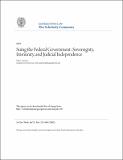| dc.description.abstract |
As I suggest below in Part I, federal sovereign immunity was adoctrine of limited effect in the early years of this republic andallowed for a number of remedies for governmental wrongdoing.Moreover, the constitutional provenance of federal sovereignimmunity is obscure, and was a matter of genuine uncertainty inearly years. Over time the doctrine developed, drawing supportfrom some aspects of constitutional architecture as well as fromunreasoning and mistaken extensions of other versions of sovereignimmunity. Among the strands of constitutional structurebehind federal sovereign immunity are Congress' powers overappropriations and the jurisdiction of the federal courts, powersthat do not necessarily require but may help explain the earlyattraction of sovereign immunity as a doctrine.As described in Part II, the sovereign immunity doctrine hasbeen dynamic, not static, as judges make choices about howbroadly or narrowly to characterize its reach in response to legislationby Congress. In the inter-branch dynamic, both Congress andthe Court have refrained at critical junctures from pressing constitutionallimits, a restraint that has created an arguably beneficialambiguity about the relationship of the judicial power to the legislativepower in resolving claims against the government. Yet giventhe adverse effects of sovereign immunity on courts' capacities toprovide individual justice, it is past time for that dynamic to moveback towards more restrictive understandings of the doctrine'sscope.In Part III, I consider federal sovereign immunity's relation toaspects of the idea of judicial independence embodied in ArticleIII of the United States Constitution. Doctrines that article IIIcourts will not enter ineffective or advisory judgments, nor judgmentssubject to legislative or executive revision or direction, coalescein cases involving claims against the government, in ways thatsuggest that sovereign immunity may have been thought to preservean aura of judicial independence. In light of the competingconstitutional norms at stake and the well-established independenceof the federal courts today, I end by urging re-interpretationof federal sovereign immunity doctrines so as to close rather thanwiden remedial gaps in the law.As I suggest below in Part I, federal sovereign immunity was adoctrine of limited effect in the early years of this republic andallowed for a number of remedies for governmental wrongdoing.Moreover, the constitutional provenance of federal sovereignimmunity is obscure, and was a matter of genuine uncertainty inearly years. Over time the doctrine developed, drawing supportfrom some aspects of constitutional architecture as well as fromunreasoning and mistaken extensions of other versions of sovereignimmunity. Among the strands of constitutional structurebehind federal sovereign immunity are Congress' powers overappropriations and the jurisdiction of the federal courts, powersthat do not necessarily require but may help explain the earlyattraction of sovereign immunity as a doctrine. As described in Part II, the sovereign immunity doctrine hasbeen dynamic, not static, as judges make choices about howbroadly or narrowly to characterize its reach in response to legislationby Congress. In the inter-branch dynamic, both Congress andthe Court have refrained at critical junctures from pressing constitutionallimits, a restraint that has created an arguably beneficialambiguity about the relationship of the judicial power to the legislativepower in resolving claims against the government. Yet giventhe adverse effects of sovereign immunity on courts' capacities toprovide individual justice, it is past time for that dynamic to moveback towards more restrictive understandings of the doctrine'sscope. In Part III, I consider federal sovereign immunity's relation toaspects of the idea of judicial independence embodied in ArticleIII of the United States Constitution. Doctrines that article IIIcourts will not enter ineffective or advisory judgments, nor judgmentssubject to legislative or executive revision or direction, coalescein cases involving claims against the government, in ways thatsuggest that sovereign immunity may have been thought to preservean aura of judicial independence. In light of the competingconstitutional norms at stake and the well-established independenceof the federal courts today, I end by urging re-interpretationof federal sovereign immunity doctrines so as to close rather thanwiden remedial gaps in the law. |

